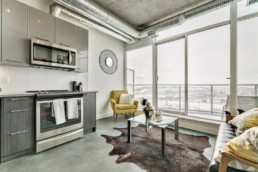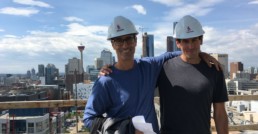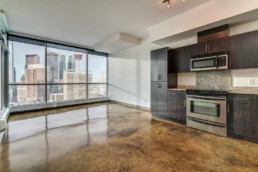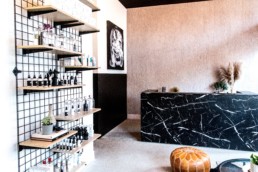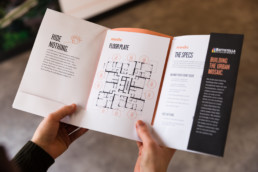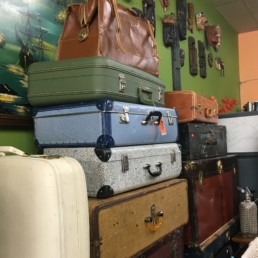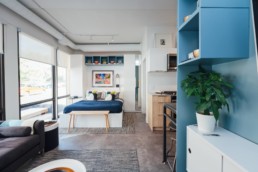The Downsizing Inspiration You Need
Have you been thinking about downsizing?
With the cost of living feeling more and more expensive and the commute feeling longer and longer. A smaller, more conveniently located condo is starting to sound dreamy.
We could argue 'til the cows come home about how downsizing is better for your wallet and social life. How you'll spend less time commuting, cleaning and maintaining and more time doing what you want to do. Hey, you can finally take up that hobby you said you were going to for the past five years. But we won't sit here and bore you.
Downsizing is a significant lifestyle change, and ultimately, the decision is yours and yours alone. However, it's always sensible to do some research, so we've made that part a bit easier for you.
Netflix Shows
It's estimated that 6.78 million Canadians have subscriptions to Netflix! But what do you watch when you've finished Stranger things 3 times, and you just can't watch Friends anymore? Why not check out some shows that are all about pursuing that smaller living lifestyle? No harm, no foul, right? Be warned, you might be on Kijiji looking for trailers after watching Tiny House Nation...
1) Tiny House Nation - The show follows experts John Weisbarth and Zack Griffin across America as they design and build tiny homes (under 500 square feet). We're not saying you have to live in a 500 square foot condo, but they do create some incredible spaces!
2) Stay Here - If you can get over the bizarre British/American accent of Peter Lorimer (and that's coming from a Brit, don't @ me). Then this show is great for design inspiration, it can also give you some useful tips if you ever decide to Air BnB your condo.
3) Minimalism: A Documentary About The Important Things - As the title suggests, this is a documentary about living with less. Just because you downsize, it doesn't mean you have to become a minimalist. But this is a brilliant documentary that focuses on the journey of people who reject the idea that things bring them happiness, and it is definitely worth a watch.
Articles
For those of you who prefer reading over watching, these five articles are brilliant. They're full of tips and techniques about smaller living, and they cover everything from organizing to finances. Who better to get inspo from than people who are living the reality?
1) Five Things I Don't Miss After Downsizing (and One Thing I Do)
2) Real Estate 2020: The Upside of Downsizing
3) 10 Super-Smart Downsizing Tips From Our Readers
4) Home Downsizing Pros and Cons
5) What I Learned About Downsizing and Condo Living
Instagram Accounts
Ah yes, the influencers. What would Instagram be without them? Don't worry; the accounts below don't post about weight loss tea, and they won't encourage you to join what feels suspiciously like a pyramid scheme...What you will find is real insights, the good, the bad, the ugly and the aesthetically pleasing and some great tips about smaller living!
A Conversation with Paul Battistella about the City of Calgary
Paul Battistella has lived in inner-city Calgary his whole life and was brought up in the building industry. He's played a vital role in the development of the city of Calgary, not just of Battistella buildings but much more.
Faith had the chance to sit down with him to bend his ear about the city, East Village, and why the Battistella Brothers chose to build two buildings there.
As an inner-city developer, what changes in YYC have you noticed since you started building?
The significant changes started from when I first started until around 2013. That was kind of the growth in development in the inner-city area. When I first started, we were one of the bigger developers in Calgary, but as things progressed, we became one of the smallest. Even though we were growing, it was in influx from firms from Toronto, Vancouver and other places that were arriving in here in response to the market opportunities that Calgary was offering and that lead to the whole wave of different development. I think it just kind of improved the quality of the units and the number of them that, in turn, increases the vitality of the city. I think more people are living here, so you get more vibrant areas then we had before.
So, the changes that you've seen have been positive?
Yes, it's about growth. Y'know, we're still not to the level of some of these aspirational cities such as Vancouver or Portland, but we've made some significant progress. We're still a suburban city, we're still a car-oriented city, and I believe that will be generational before that converts, but I've seen an improvement, and that's the most significant change that I've noticed.
How has East Village changed since you build ORANGE LOFTS?
Well, the first time we got involved in ORANGE LOFTS, there was a plan with the City and a group of private developers to redevelop the whole area, including running a canal right up 5th st from the river. They had a whole little mini Venice water feature that they wanted to build and more, and then suddenly, that entire plan (while we went ahead and built our building) collapsed; it just vanished. The whole deal with the City and the developers fell apart and basically sat in hiatus for almost a decade.
Then they re-established everything, and they did all of the infrastructure work and the improvements through CMLC. They raised all the roads; they improved the sidewalks. They were able to complete all of the development they needed to, to make that area what it is. And that's what's acted at the catalyst. Now you've got the library, you've got a bunch of new buildings, you've got the grocery store coming. Y'know everyone can argue that it could have been carried out more efficiently, but it did accomplish what it set out to do. To have all of those amenities and infrastructure in place, it actually has a chance and a footing to become a real urban neighbourhood. I'm not sure it's there yet, I still think we need more development there; we need more residential and commercial, but it's significantly better from the day we went in.
My son was born in 2003, and that's the year ORANGE LOFTS was completed, so we're here 17 years later, and we're just finally now at, what I think, is the start of a good urban neighbourhood. But that's how long it's been. From the start to the point we're at now where, hey, we've got a good foundation to make this vibrant place happen. It's still got a ways to go, and it's crazy that it's been 17 years to get to this point, it's a long, long time.
So, how come you built two buildings in East Village?
Firstly, we were looking for affordable lands that had compelling upsides, and we'd heard about what the city was planning. We'd found both the lots (ORANGE LOFTS and INK), and we bought them both at the same time. So we built ORANGE LOFTS, then the whole partnerships with the developers and the city crumbled and faded, so we didn't bother going onto the next project because you know what, there was no great story to sell there. Nothing's happening; it's just going back to being this desolate neighbourhood. So we left that site and moved onto 1st street where we built CHOCOLATE and COLOURS. Then we moved into Kensington, and then during that time frame, the city invested all that money and work in East Village, and everything came to fruition, so we were like hey! We have that site there; let's go back! So that's what ended up happening.
Did you know, at the time, that ORANGE LOFTS would be as iconic as it is?
No, I think at the time. You know, it's typical of what we do. Great ideas are typically borrowed from somewhere else. So we borrowed this idea right out of Vancouver. Kind of a cooler, light, industrial area that had a bunch of these artist lofts/studio buildings and it was actually my mum that found it. She went out, she discovered it. She loved to stay in Vancouver, so she walked the city and the neighbourhoods. She'd look at all the developments, and she found her inspiration, then she found the architect, and she brought us out there to see it, and we said yeah, we could do this in Calgary because it's just so unique. So that was the instigator that made us build that unique building. That's probably, what allowed it to keep its value, even when the other development work cratered because it was so unique. There's nothing else like it in the city, and that's what made it be able to stand its ground. The values didn't fall off, even when everything else failed in that neighbourhood. It held it's own because there was nothing else like it.
What changes would you like to see for inner-city Calgary?
I'd like to see a time when there are as much consideration and investment in growing urban communities as there is in growing suburban communities. We pay for road infrastructure; we pay for interchanges and more. Hundreds of millions of dollars of money from taxpayers who are in these established area communities flow outwards to help facilitate that development on the periphery of the city.
To me, and I have biased, but I don't find that's the greatest way to live a life. Because to live a life out there, you need to be in your car all the time. You're continually driving; you're driving to go to a grocery store, you're driving to go to school, you're driving to go to recreation facilities, to entertainment. There's nothing you can do, living in those communities that doesn't require you to get inside your car and drive. And I'd like life to be so you don't need to have a car, and if we can get closer to that, I'm not saying it has to be one or the other, but if we can get to that place where we can truly live without a car, then you get a more interesting and dynamic city.
Any major, large city in the world or the coolest city that you want to visit, you can live in those cities without a car, and you know it when you arrive. You can feel it. There's an energy, you experience it when you walk down the street, and we don't have much of that here. We have pockets of it here and there, but we don't have a concentration of it, and really, you need a car to visit these pockets. Whereas if you're in cities such as London or New York or even in smaller cities like Portland, you can live in the Pearl district; it's high density, it's industrial, it's got jobs, and you can walk to the downtown core. It's connected. And it's that connection between these pockets that I feel we're missing.
Humans of Battistella: A Conversation with Jeff from COLOURS
We may develop the buildings, but it's the people who live and work in them that bring them to life. Characters from all walks of life occupy our buildings across the city, and we want to get to know them better.
Faith sat down with Jeff, a COLOURS resident, to find out more about him and his opinions on living in inner-city Calgary.
How long have you lived in COLOURS?
We moved into COLOURS in 2012. Initially, we rented, and then we bought in the building. Now our family has grown, and I work from home, we're looking to move somewhere a bit bigger (although still in the city), but I love the condo lifestyle. I love being able to watch the world go by; I love the floor to ceiling windows and the fact that my son sits and watches the world go by with me. I love feeling like I'm part of something. When I take the dog for a walk at 10 pm and see people lining up outside habitat, it makes me smile.
Did you grow up here?
I'm born and raised Calgarian, but I grew up in the suburbs. So I was used to driving everywhere, I got my license at 16, and that was what I knew. My wife, on the other hand, grew up in Kensington and was used to walking everywhere and being in the center of everything.
What attracted you to the building and the neighbourhood?
When it came time to move out/in together, we'd decided that location was one of the most important factors. I had friends/colleagues who lived Downtown who were able to walk to work, and that's what we wanted. There was a revitalization of the area happening at the time, and we loved the architecture of the building. When we first tried to rent in the building, we were shown around with two other couples, and my wife said, this is it. Unfortunately, we didn't get it. A few months later, we came across a listing that had just been posted for the same floor plan only on the 15th floor, so we messaged the guy, and we got it! We were lucky, though, he told us that his phone had been blowing up. It was a totally different time back then! Then we were lucky enough to be able to buy in COLOURS and have lived there ever since.
What changes have you noticed in the neighbourhood?
When we first moved into the area, it didn't have the best reputation; however, it was on the up. Since 2012 I genuinely believe that the arrival of businesses such as 10-foot Henry, Two Penny and most recently Leopold's Tavern have completely transformed 1st and it's reputation. It's now a street that people want to come to.
What's something you hope to see happen in the area in the future?
I'd like to see the Green Line go in. Decent public transport for cities is so important, and the Green Line will really help boost the area. I'd also like to see more of a connection to 17th AVE. At the moment, there's some dead space, and I believe that once it's filled and there's a connection between 17th and 1st, it will be great for the area.
What's your favourite thing about Victoria Park?
The location is key. As young 20, something's we were right in the midst of things, and we were able to walk to work. Now, as parents, we're still in the midst of things, although the places we tend to go to are a bit different. One of the best things about the area is the Beltline Aquatic and Fitness Centre. It's truly the heart of the community. It's cheap, it serves so many purposes, there's a free after school program, and I even run a floor hockey game there every Monday.

Get To Know: Insurance for Your New Condo
A question we get asked a lot is: do I need condo insurance? And the answer is, you're not required to have condo insurance, but it's damn sensible to protect your assets.
Why do you need condo insurance?
To protect you and your investment. The main insurance policy put in place by the condo association will cover things such as the floors, walls, roof, elevators, common areas, etc. However, your personal policy should look after you, your belongings, and your condo.
What kind of insurance do I need?
Your insurance should cover any renovations you have made or plan on making. It should definitely include your contents, and you should think about things such as loss assessment coverage, contingency coverage, third party liability insurance, and additional living expenses coverage.
Does condo insurance cover my storage locker?
Most policies will cover the contents left in your storage locker, but make sure to read the fine print because you don't want to get caught out!
Where should I get my insurance?
The best thing to do is to shop around, there are plenty of comparison websites but don't forget to ask your friends and family too. Find the policy, price, and company that best suits your needs. It's not exactly exciting, like it is picking out your furniture, but it's essential to protect your assets.
How much does condo insurance cost?
The average cost of condo insurance can range from $100 to $400 per year. It all depends on your policy and the value of your personal property.
Who insures the building?
The condominium corporation, by law, is required to maintain an insurance policy that protects the building, common areas, and condo units against destruction or damage. Don't forget, if it's a new building, it will also be covered by a warranty policy.
Humans of Battistella: A conversation with Annie from XO
We may build the buildings, but it's the people who live and work in them that bring them to life. People from all walks of life occupy our buildings across the city, and we want to get to know them better.
Annie is an accomplished Biologist and a confident businesswoman. She's the brains behind XO Treatment Room and XO Facecare, which just so happens to be internationally known. She also happens to be one of our tenants in COLOURS. Faith sat down with Annie to find out more about her story and her decision to locate her business in Victoria Park.
How long have you been in Victoria Park?
Just over five years.
Why did you choose this spot?
I used to live in CHOCOLATE, I had a gorgeous condo, and I just loved this street so much. Vine Arts popped up when I lived there, Lola. You know it's changed a lot over the past 5/6/7 years, but I was just so partial to this street. I lived in that condo until I got married and then when I got married we bought a house. We both sold our condos, but I missed this area so much. Then I saw this spot open, which used to be Atomic Subs, which everyone knows, and then it was a sandwich store, and then it was empty. So, there was this For Lease sign, right as the economy was starting to plummet but I was like, I should do something there, I should do something there.
What can I do that involves science, lasers and chemicals that isn't illegal. I love skincare; I'd worked with tissue and skin for a long time. I have a biology degree, so I understand all this. Anyhow, I was like, right; I'm going to open and do laser stuff. But I'm not going to make it cheesy; it's going to be legit and cool like real stuff that works.
And Barb (Barb runs our office) was amazing because I have no history of business, I've never done anything before. I just came to her with this grandiose idea, and I was like, 'I would like to lease that spot please,' and she said yes. And the way you see things open and close now, it's like 'why the hell did she listen to me?!' but I'm so grateful that she did. I owe Barb for saying yes.
So we opened up, and we grew and grew and grew and grew, and in November, we were in Oprah Magazine for crying out loud. It went from me, sitting in my garage wondering 'what should I do?' and now we're in Oprah Magazine.
Do you think the location of XO has contributed to your success?
Yeah, it does. It's funny when it first opened here I was convinced that every single person from every condo building around was going to come down here and have their face done. But it's not necessarily the case, most of our clients are people that work Downtown. We're nice and close, we have ample parking, and they come in, they have their treatment, and they go back to work. And I know they're from the DT area because we used to be open Saturdays and it was our quietest day. So we're now Monday to Friday.
What changes have you seen on 1st since you've been here?
It's been all growth. I think people naturally go to mission or 17th, but this feels like a community. It's not as intimidating; it's not as busy with traffic. And honestly, this isn't a street where I see things open and close, but you also don't see Canadian Tire choosing this street. It's entrepreneurs, and it's a community, and it has been a successful growth. Like restaurants, for example, if you wanna eat out, then this is the area to be in — facial, cocktail, dinner. Perfect.
What changes would you like to see in the future?
Nobody loves change, right but the city has very thoughtfully planned this area. It worked, and it did improve, and it did get better. This (where XO is) was the nice part of the street, and then you got down to Mac's Circle K... But they changed all of that too by putting the median in and putting the nice lamp posts in. They have improved that area a little bit now. I don't know what I would say for more change. I like the way it's going. I like the slow continual growth. Things that grow too fast implode. Things that grow too slow get stale. It's just going at a nice pace. I'm really looking forward to this Underwood Food Court opening.
Do you see yourself staying in this area?
Yes. I'm very emotionally attached to this area. I just re-signed my lease and did a full renovation in here. When planning the renovation, I felt like I should wait until I resigned my lease because that's the sensible thing to do. So when my designer came in, he was like 'right let's do this,' but I was a bit more cautious because I wasn't sure if I'd be allowed to and he was like 'well, there's a lot more options out there' and I was like no no no, I'm very emotionally attached to this spot. And he was like 'just look,' and so I did and nothing was like, just no. I'm happy where I am, I don't want anything too big, I'm a 1,000 sqft, it's super functional, I was able to do everything I wanted (Battistella were amazing, they just said yes!) and it looks super high end and awesome and I love the street.
We definitely try our best, you know, people assume we're a huge company, but we're only 12 of us on the team. Just because we sell high ticket items doesn't mean there's a million of us. I guess it's the same as you, with international recognition, people might think that you're a big company.
Yeah, for sure, we got a lot of people contacting us through the telephone (which is a weird way to contact us) from the Oprah feature. Stacey (Annie's protege) would be talking, and I was like, tell them you'll transfer them to HR or Marketing. It was very funny! It took us a minute, but then we realized they really did think they were talking to a big company.
Are you selling internationally?
Yes absolutely. The UK is a very popular hotspot and, of course, the States and across Canada. But you know we formulate and create everything ourselves here, we physically sell in the store, products can be purchased online, and I have my treatment room where I do facials and laser and technology treatments on people. So everything just connects, and I have such a passion for it. I get to do the creative part; I get to do the science part, I get the human interaction, and I get to bring my dog to work. It really is a dream come true.
What the Heck is a 10-Day Rescission Period?
Buying a new condo is a big, overwhelming, crazy, fantastic, scary decision. But you're almost there. Now, what the heck is a 10-day rescission period?
The process of buying a condo is exciting, but it can be a little scary at times too. After shopping around (a lot), you've finally found your perfect pad, and now it’s time to take the big leap to reserve your new place.
It’s at this moment where those butterflies in your stomach are fluttering frantically! You're both thrilled and nervous, and you're filled with questions you didn’t even know you had. Questions such as; what are rules of the condo building? What is covered under warranty? How are condo fees determined? Your head is full!
These questions are totally normal, and it’s the very reason why the Condominium Property Act of Alberta provides a 10-day Rescission Period to all new condominium purchasers. Think of it as your period of condo-buying education!
How does it work? Well, the 10-day Rescission Period starts on the date you receive the Disclosure Documents from the developer. Or from the date you and the developer sign the Agreement of Purchase and Sale.
Some people refer to it as 'the cooling-off period.' It’s there to allow you to time to learn as much as you can about the condo development. And to ask questions, of course!
Along with a copy of the Purchase and Sale Agreement, the Disclosure Documents (as required by Section 12 of the Condominium Property Act Alberta) will provide details about the warranty, amenities and finishes, as well as bylaws, insurance, and financial information including a proposed budget.
But, you should also take advantage of the 10 days to do a few other things:
Take a condo off the market – In pre-construction condo sales, the best units are often snapped up quickly. Which is why it's important to move fast to get the condo you want. Thanks to the rescission period, you can use the ten days to reserve your favourite condo while you finish your research.
Get reassurance from friends and family, a real estate lawyer or accountant – Whether you’re a first-time buyer or a seasoned investor, use this time to seek advice and reaffirm your decision. Bring in Mom and Dad and your Uncle Norman. Show off the show suite to your BFF, work the numbers with your accountant. Feel confident and comfortable. Remember, this is your future home, and it won't feel like a home if you're not confident about it.
Secure financing – Meet with a mortgage specialist from a bank or brokerage to make sure you’ll qualify for a mortgage on your new place. And, while you’re at it, get a Builder Rate Hold for up to 24 months. Ever heard of a deposit bond? Talk to us to find out how you can buy a NUDE condo with only a 5% deposit, and defer the rest of your down payment until closing.
In the end, it’s as important to us that you are happy with your new home purchase, as it is to you. So that's what the heck it is, the 10 day rescission period is there to help you be sure that you're making the right decision.
If you have more questions or are curious about NUDE, get in touch with Sales Lead Renée via text 403-452-9268 or email renee@battistella.ca.
What Is Your Walk Score?
Location, location, location. One of the most important factors when you're choosing where to live, but how do you decide if a location is right for you? Especially if you're looking for a lifestyle that includes more free time and less time commuting. Well, have you heard of Walk Score?
Walk Score is a tool that measures the walkability of any address, and it has us nerd-ing out. It analyses hundreds of routes to nearby amenities. Not only that, but it also measures access to public transport, and it measures whether a location is good for biking.
Interestingly, Calgary is ranked the 10th most walkable large city in Canada. It has a walk score of 48, a transit score of 50, and a bike score of 50. That basically means that overall, YYC is a car-dependent city...which doesn't really come as much of a surprise.
HOWEVER, when we looked into the walkability of our latest building NUDE, we did a little happy dance. We build in inner-city Calgary because we believe in helping revitalise YYC. As others are sprawling out, we're going up, and it may mean our condos are a little smaller, but you can't beat having our great city as your back yard.
NUDE is located in the West Beltline and has a walk score of 97, that's more than double than that of YYC as a whole. It has a transit score of 73 and a bike score of 98. That means that NUDE is a 'walker's paradise' (their words, not ours). It's also a 'biker's paradise,' and it's classed as 'excellent' for public transport.
Now THAT's a good location (location, location).
To read more about NUDE's walkability score, click here. But make sure you have some free time because we guarantee you'll get carried away.
Too Much Stuff: Sorry Mum and Dad
After moving to Canada with only one and a half suitcases, I've started to realize. I have too much stuff.
Back home in Portsmouth (UK), my partner and I lived in a small one-bedroom flat (apartment); it wasn't more than 600 sqft. We'd lived there for two years, so you'd expect to accumulate some stuff, but in the weeks leading up to our move across the Atlantic, I made numerous trips to the tip (the dump). I did a car boot sale (a yard sale but out of the trunk of our car), and I gave away a lot of stuff to friends.
I took multiple bags of clothes, nick nacks, books, etc. to charity shops (thrift stores) and stored the rest in my parent's house — much to their dismay. We even sent some of our furniture to France. Although in our defense, my better half's parents live in France and have lots of storage, so that decision wasn't as excessive as it sounds.
But just thinking about the sheer amount of crap I got rid of and the amount of things that are still stored in every nook and cranny in our parent's houses, I feel a little embarrassed, and I realise. We still have too much stuff. I thought I was being mindful of what we were keeping, but I recognise now, there was definitely more stuff I could have donated. But not my vacuum, I bloody love that thing.
Since moving, my mindset has started to shift. I am not a minimalist (by any means), but I've started to be more thoughtful about every single purchase. We don't know if Canada will become our forever home, so every time I buy something, I ask myself the following questions:
Will this enhance my life over the next year and a half?
Can I take it back on a plane with me?
Do I want/need to take it back with me?
And I really hope that I can continue with that mindset because having too much stuff is a problem. I now have more square footage at my disposal (you guys have seriously big homes, it's crazy) but have less than half the things around me, than I did six months ago, and it's freeing. They say a tidy house equals a tidy mind and they're right. I used to come home and audibly sigh at the stuff everywhere. I used to get frustrated at trying to pull the right pan out of the cupboard and having to move things around every time I cleaned, which was a lot by the way because clutter is a dust magnet. But I'd convinced myself that I needed all those pots and pans, that I needed the extra throw pillow on the sofa, the numerous candles even though I'd barely ever light them.
Now I come home and don't feel claustrophobic; it doesn't take me as long to clean even though it's a bigger space, and I don't look at things and think why on earth do we have that? The stuff I do have makes me happy because I made a conscious decision to choose it.
It's been a challenge, though; it's hard to avoid the temptation to fill space, especially when I'm trying to make a new country feel homely, and I believe that's where part of the problem lies. We're bombarded with temptation to buy things on a minute by minute basis. We continually see stuff that we're told we need to buy to make our home cosier or our lives easier, and we're conditioned to think that the more things we have, the more successful we are, and that space is there to be filled. I've started to realise that these things aren't true. The only thing that really matters is your happiness, and for me, now, that means having less stuff.
So, to our parents, I apologise for all the unnecessary crap we left behind - I promise to sort through it when we come back to visit.
This blog post was written by Faith, our social media gal and resident Brit.
Smaller Living: The Inspiration You Need To Downsize
Is one of your New Year's resolutions to downsize or, at the very least THINK about downsizing?
With the cost of living feeling more and more expensive and the commute feeling longer and longer. A smaller, more conveniently located condo is starting to sound dreamy.
We could argue 'til the cows come home about how downsizing is better for your wallet and social life. How you'll spend less time commuting, cleaning and maintaining and more time doing what you want to do. Hey, you can finally take up that hobby you said you were going to for the past five years. But we won't sit here and bore you.
Downsizing is a significant lifestyle change, and ultimately, the decision is yours and yours alone. However, it's always sensible to do some research, so we've made that part a bit easier for you.
Netflix Shows
1) Tiny House Nation - The show follows experts John Weisbarth and Zack Griffin across America as they design and build tiny homes (under 500 square feet). We're not saying you have to live in a 500 square foot condo, but they do create some incredible spaces!
2) Stay Here - If you can get over the bizarre British/American accent of Peter Lorimer (and that's coming from a Brit, don't @ me). Then this show is great for design inspiration, it can also give you some useful tips if you ever decide to Air BnB your condo.
3) Minimalism: A Documentary About The Important Things - As the title suggests, this is a documentary about living with less. Just because you downsize, it doesn't mean you have to become a minimalist. But this is a brilliant documentary that focuses on the journey of people who reject the idea that things bring them happiness, and it is definitely worth a watch.
Articles
1) Five Things I Don't Miss After Downsizing (and One Thing I Do)
2) Downsizing in Style in a Toronto Condo
3) 10 Super-Smart Downsizing Tips From Our Readers
4) Home Downsizing Pros and Cons
5) What I Learned About Downsizing and Condo Living
Instagram Accounts
Smaller Living: The Inspiration You Need To Declutter
Is one of your New Year's resolutions to declutter?
You've had a long day, you've just got home from work, and as you walk through your front door, you trip over four pairs of shoes you have nowhere to put. You look around, and you see stuff spilling out everywhere, and it's frustrating as hell. Don't worry; you're not the only one. We're all guilty of it.
Decluttering is one of those mammoth tasks that we all put off; in fact, it sometimes feels like it would be easier to move into a bigger place than sorting through everything, but it doesn't have to be that way, and it doesn't have to be an all-consuming task.
It's no secret that we build smaller condos. And one of the things we hear frequently is, 'what am I going to do with all my stuff.' In response to that, we ask, 'how much of your stuff do you actually use or need?'
Sometimes the answer is 'all of it,' but most of the time, the answer is 'not that much.' And that's when we suggest decluttering and rethinking about whether they could live in a smaller space or not.
Of course, you don't have to buy a new condo as an excuse to declutter (although it is a good one). You don't really need a reason, but trust us, you'll feel so much better for actually doing it. We've put together a list of books, blogs and shows to give you the inspiration you need to declutter and get rid of those shoes that keep tripping you up.
Shows
1) Tidying Up With Marie Kondo - Of course, we were going to include this one. As you probably already know, Marie Kondo is an organizing consultant who has dominated our screens, vocabulary and Instagram feeds for the past few years, and although the whole 'sparking joy' thing might seem a bit ridiculous, she has a point. We should only be keeping the things that spark joy because the rest is just holding us back.
2) Hoarders - If hoarders doesn't make you want to throw everything away/donate, then we don't know what will.
3) Home Declutter Series - Okay, so this a YouTube series we came across recently by YouTuber Belinda Selene. It's a short series of videos that showcase how Belinda declutters and organizes her home. It's great if you don't have the time to watch the hours of Marie Kondo.
Blogs
1) Reddit >> Declutter - Bear with us on this one. Reddit is a ridiculous place, but it's chockablock of real people giving real advice just because they want to help. When you're feeling overwhelmed, sometimes the advice from the professionals can feel out of touch, but on Reddit, it's real advice for real people.
2) The Home Edit - For all sorts of home, lifestyle, and decluttering advice, The Home Edit is the one. Their blog posts are a good length with beautiful imagery and step by step guides.
3) Get Sorted - Kelsey is a professional organizer, business owner, self-care advocate and wellness enthusiast based in Toronto. She believes in a wellness approach to organizing and offers interesting insights into how our mental wellbeing is connected to the stuff around us.
Books
1) It's All Too Much Stuff: An Easy Plan for Living a Richer Life with Less Stuff - Written by Peter Walsh from Clean Sweep, this book is filled with real-life examples and advice for people from all walks of life, living in homes of all sizes.
2) The Gentle Art of Swedish Death Cleaning: How to Free Yourself and your Family from a Lifetime of Clutter - A book about the Swedish decluttering process of clearing out unnecessary belongings sooner rather than later.
3) 10-Minute Declutter: The Stress-Free Habit for Simplifying Your Home - The perfect book for busy people, which is all about getting into the habit of decluttering daily.

